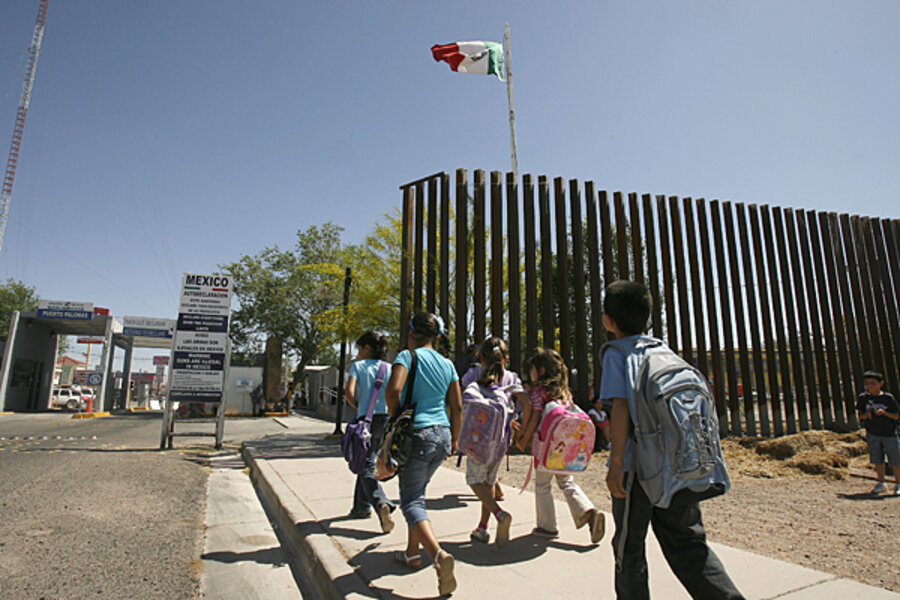Mexico: Border schools adjust to influx of English-speaking students
Loading...
| HERMOSILLO, MEXICO
Elementary students at Lamberto Hernández School in this northern Mexican city were long gone by the time teachers sat down recently to learn about the growing population of English-speaking students in their classrooms.
At the teacher training workshop, facilitator Laura Guadalupe Zatarain asked the educators in English to fill out a simple form written in German. The teachers looked at her, puzzled.
"This gives you an idea how these children feel when we start speaking too fast and they have trouble understanding," Ms. Zatarain says, switching to Spanish. "Especially about a subject like math, or history, or President Benito Juárez, someone they have never heard about."
State education officials point to Lamberto Hernández, a school named after a late educator from the region, as a model for working to create an environment that embraces students and parents arriving from the United States with little or no knowledge about Mexico's school system. Thousands of school children have arrived in Mexican schools from the US in the past several years amid a record number of deportations and a foundering US economy. [Read The Christian Science Monitor's story on US-educated kids adjusting to school in Mexico.]
"The school's response has been excellent," says Jesús Eduardo Ramírez Cordoba, who oversees international affairs for the state's Secretariat of Education and Culture (SEC).
Lamberto Hernández School principal Hugo Efrén Molina says his hope is to turn the school into a magnet for those students arriving from the US. In addition to offering professional development to teachers, plans are underway to extend school hours and build a cafeteria, which students who attended US campuses sorely miss. The school only has a snack bar.
'In the interest of students'
Mr. Molina and English teacher Ms. Zatarain underwent special training by the SEC on how to deal with the influx of transnational students. Before leading the weekly two-hour sessions at their school, the pair also attended workshops at the University of Arizona in Tucson and visited several elementary schools in the area to observe US teaching methods.
Teachers at all levels at Lamberto Hernández, from kindergarten through sixth grade, are expected to attend the evening workshops lasting two months. The SEC plans to offer the teacher training at other schools in the future, as well.
Lamberto Hernández teachers are proactive when it comes to embracing student populations with unique needs, says principal Molina. The staff previously underwent training to teach students with disabilities.
"If it's in the interest of students, staff members are not afraid to be part of change within the educational system," Molina adds.
At the second workshop recently, the principal tried to familiarize teachers with Mexico's migrant population through a discussion of the history of migration between the two countries as largely driven by poverty in Mexico and a demand for workers in the US, particularly through crisis periods including the Mexican Revolution, World War I, and World War II.
'They are the same as us'
Now, new migration patterns are returning Mexican nationals to their homeland years after they settled in the US, married there, and had children. Back in their native country, many of these families are unappreciated, Molina says.
On the wall behind the principal, a hand-written sign describing Mexico's migrants reads: "They are the same as us, and they have the same rights."
Teachers read from textbooks that touch on the reasons for the reverse migration currently taking place, and oftentimes, Zatarain told the teachers, parents are deported while their children are in school and the experience can traumatize youngsters.
Many of those children now in Mexico's schools will need patience and understanding to help them integrate into academic and social life, she says.
One teacher talked about a student in her classroom who is more comfortable speaking English than Spanish and initially refused to wear a school uniform. Another teacher recalled the student who couldn't adapt and eventually dropped out of school.
"The challenge is to make sure we are helping students learn effectively in what is a new environment for them," says first grade teacher Karla Patricia Montaño.
Ms. Montaño, who has taught for 15-years, says she is up to the challenge.





